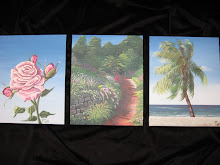Into the 21st century, painting is an ongoing river of creativity. It would be, ostensibly, difficult to imagine a wall without paint. When a thin layer of paint is applied to a wall it converts to an opaque solid film. So basically, what you see is what you get. But when you apply the Rag Rolling technique to your paint job, not only do you achieve a soft, textured effect on a wall, you even add depth and excitement to an otherwise bland surface. This article will explore the different techniques used in creating that lustrous, textured look that can only be achieved with rags.
Now let's get the terminology out of the way first. Rag rolling and ragging are two different things. Rag rolling is rolling or ragging paint on; and ragging is rolling or ragging paint off. The finished product is totally different, however. I'll cover this in a minute, but before I do, please make a note of this: to see the effect you like best, use a piece of cardboard to try out both methods.
Essentially, the principles of rag rolling and ragging are pretty much the same. What will create the difference between the two methods are the shape of the rag and the shape it creates on the wall. Between the two techniques, you will get the appearance of a vertical pattern with rag rolling, whilst ragging will appear sharper in texture-more arbitrary, if you will.
Preparation is easy. With both techniques, you'll want to ensure that the rags you use are wrung first before you apply the rag onto the base coat on the wall. It is important that all of the excess paint--or water in ragging--is removed from the rag if you want to get the best effect. Have several rags to work with, and pour glaze onto a paint tray where you will be dipping the rags into. Give them a good soak. You will be using one rag at a time, so place the extra rags in a bucket and place a lid over them to keep them moist.
Rag rolling paint on involves rolling paint onto the base coat. You need to use both hands to do this properly. The technique is simple: just roll the rag down from the top to bottom of the wall. When the impressions fade, get another rag from the batch you prepared earlier. Make sure you overlap each strip as you continue to roll.
Ragging paint on involves applying a soaked and crumpled rag onto an already glaze base coated wall. Ragging can create a scattered effect, thus in order to achieve a concentrated effect, overlap areas when you apply the paint. Dip the rag, wring it, and then dab it onto the wall. When the color gets lighter, just dip it again and continue dabbing.
Rag rolling paint off is a technique that involves working with a freshly glazed surface and simply applying a wet-with-water but wrung rag to roll the wet paint off. Use a clean rag once your rag gets saturated with paint. Simply apply glaze in small sections and continue rolling the wet paint off. If you want a more subtle effect, wet your rag with water and wring out before rolling paint off. Once the rag becomes saturated with paint, start again with a clean rag.
Ragging Paint Off is similar to ragging paint on, except in this technique you dab the paint off. For a more subtle effect, wet the rag, wring out the excess water, and crumple the rag. And when it's saturated with paint, use a clean rag.
Creating illusions of fabric, stone, wood and other natural surface materials can be easily achieved using faux paint techniques such rag rolling and ragging. It is the way you apply these techniques to the wall that determines the texture. Whether you rag on or rag paint off, you will get a textured look in the end, but to see the effect you like best, try using a piece of cardboard to try out both methods first.
About Author:
Anthony J. Namata is a successful Internet Marketer and author of How to Become An International Gemstone Dealer and his popular online journal Diary Of An Internet Marketer
Shop for your favorite products and name brands AND help the world become a better place...Find out more at: http://www.maxmalls.com
Article Source: http://EzineArticles.com/?expert=Anthony_J._Namata
Saturday, March 8, 2008
Subscribe to:
Post Comments (Atom)














No comments:
Post a Comment